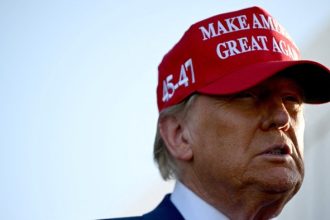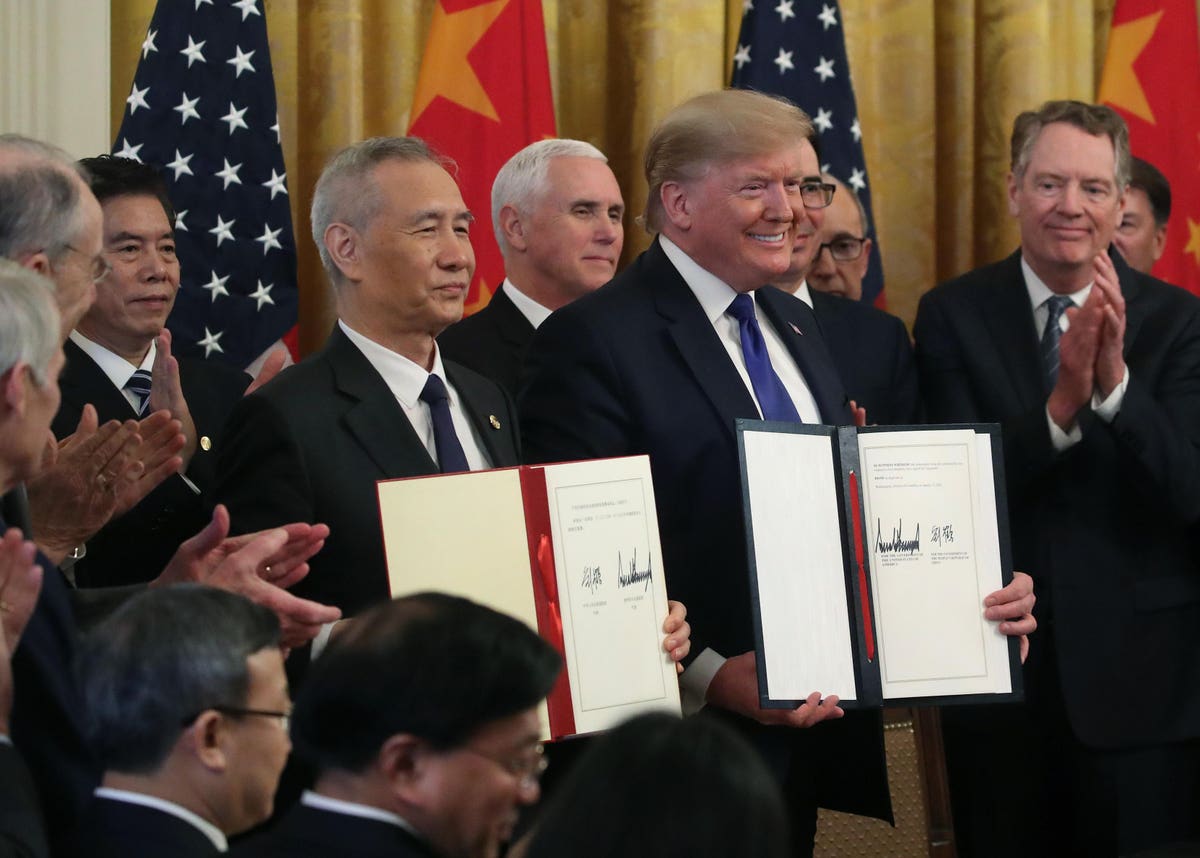Some say the former president’s tariffs were an act of genius,
Others say – not true.
His recently announced 10% retail tariff plan – coupled with team Biden’s lackluster trade policies, have steered America’s 2024 retail scenario towards a dangerous place within a sea of already turbulent waters.
One reason for retail concern – relates to the burning political question as to whether Trump’s newest tariff idea is a solo act from the former president, or is “ring around the collar” a plan to transition the Republican Party from pro-business to anti-trade?
Whatever the case, retail needs to know.
The former president’s newly minted tariff chatter is reminiscent of a familiar comedy/horror movie that we have seen before. Retailers will remember the fictional skid row neighborhood in New York where Mushnik’s flower shop once displayed a larger-than-life plant named Audrey 11. This unique “plant” was purchased from a Chinese flower shop to drive more business as Mushnik’s was struggling to stay afloat in the rough-and-tumble world of New York retail. When store employee Seymour Krelborn accidentally pricked his finger, he quickly learned that Audrey 11 plant would grow faster – if given a supplement of human blood.
In private, Audrey 11 continued to dine on more and more humans, but her popularity continued to flourish and draw even more customers to the shop. Eventually, the plant’s rapidly growing size and hunger for blood became too problematic, and the situation quickly spun out of control. Seymour Krelborn finally electrocuted Aubrey 11 which, in turn, blew up the store and (perhaps) ended the problem. Of course, all this excitement transpired during the fabulous movie called Little Shop of Horrors which was released for the holiday season in 1986. When the movie premiered, some retailers probably noticed that the music, comedy, and horror of their fantasy world was playing out on movie screens across America.
Coincidentally, with the blood theme in mind, and not too long after the release of Little Shop of Horrors in 1986, another quasi-drama unfolded when businessman Donald Trump, dipped his toes in the political arena by making a well-publicized comment about developing a retail protectionist strategy for America by using tariffs to elevate the cost of imports competing for a share of the USA market. His target country (at the time) was Japan.
During a 1989 interview with Morton Downey Jr, Mr. Trump articulated has retail inspired comment that Japan has “systematically sucked the blood out of America – sucked the blood out.” He also said that Japan had “gotten away with murder. They have ended up winning the war” and he felt that America should levy a 20% import tariff on Japanese retail products like Honda cars, Toyota cars, Sony Walkman, and even Panasonic VCRs.
Years later, with his 1989 Trumpian proclamation in the rearview mirror (but not forgotten), Mr. Trump continued to fine-tune his America is being taken advantage of message as he promoted his view of international matters – which always included at least one antagonist. For Mr. Trump, the story began with Japan, turned to China, moved to a select group of other countries, and now (most recently) has targeted for the rest of the world.
In January of 2016, it was candidate Trump who told the NY Times Editorial Board: “I would do a tax (on China) and the tax, let me tell you what the tax should be…..the tax should be 45 percent.” In September of 2016, Mr. Trump appeared on CNBC Squawk Box and answering a question from Anchor Becky Quick, he said: “Look, we owe China $2 trillion okay? $2 trillion. I mean, hard to believe, but that’s what it is. Think of it. They suck the blood out of us and we owe them money. That is a hard one to do. They are magicians.”
Once the former president had won the election in 2016, he set his sights directly on China and, as he promised, targeted them for retail tariffs. Of course, the nationalists in the president’s camp viewed the tariff idea as a genius effort to contain China who, they decided, had been taking unfair advantage of American trade. Globalists, outside of the President’s inner circle, viewed the tariff policy as ineffective and counterproductive. However, all that being said, while past history is not necessarily a predictor of the future, Mr. Trump did launch four tariff tranches against China – which eventually led to the failed China Phase One Trade Deal – signed in the White House on January 15, 2020.
Now, as the former president runs for office once again, and he prepares his economic and political strategy for the upcoming election – it is clear that tariffs have become a key component to his political strategy. THE PROBLEM is that his target is not just Japan or China – but rather ALL COUNTRIES that import products into the United States.
In mid-August of this year, the former President summoned key economic advisors to Trump National in Bedminster, NJ to map out portions of his 2024 economic agenda over dinner at the club. They discussed setting a “universal baseline tariff” against all imports from all countries. The former president then appeared on Fox Business with Larry Kudlow, where he talked about an automatic 10% import tariff for every country and proceeded to call it a “ring around the collar” (which was a curious metaphor based on old commercial for Wisk detergent).
On August 22nd, Jeff Stein of the Washington Post wrote an excellent article discussing consequences: “Trump vows massive new tariffs if elected, risking global economic war.” In the article, Mr. Stein quotes Michael Strain of the American Enterprise Institute (a center-right think tank) who said that Candidate Trump’s proposed tariff: “would be a disaster for the U.S. Economy. It would raise prices for consumers and be met with considerable retaliation from other nations, which would raise the costs facing U.S. Businesses. It would reduce employment among manufacturing workers. It would be very, very bad.”
The next day, August 23rd, the Wall Street Journal Editorial Board wrote a fabulous opinion piece noting that: “Trump Courts a Global Trade War.” The commentary reminds everyone that the former President may be prone to exaggeration, but when it comes to economic policy, he “means what he says, for better or worse.” The opinion piece also notes that “protectionists pitch tariffs as a tax on other countries, but “American consumers pay the price.” It also mentions that the former president’s idea of using trade deficit as a “useful measure of economic performance” isn’t quite what he claims it should be.
It is true that the former president believes trade deficits are bad, but he neglects to heed the wisdom of the esteemed economist Adam Smith who wrote back in 1776 that: “Nothing, however, can be more absurd than this whole doctrine of the balance of trade.” To prove the point, look closely at the balance of trade with China around the time he was in office. The deficit (exports minus imports) before President Trump took office was (in millions) $-346,825 in 2016. After he took office, it was $-375,167 for 2017.
When the China tariffs kicked in by the middle of 2018, the deficit for the year was: $-418,232. In 2019 the deficit reverted back to the 2016 level of $-342,629.
Shortly after the editorial board of the Wall Street Journal released their opinion piece, the former president responded on August 30th with a letter of his own: “Donald Trump: My Tariff Policies were a Success.” Mr. Trump carefully articulated several nuggets of Trumpian wisdom: “the die-hard globalists at the editorial board still have not learned their lesson” and “our country is being plundered” and “the best way to stop this hemorrhaging of America’s lifeblood is a simple but powerful tariff on most foreign products” and “I am proud to be the only candidate for president who believes in true economic nationalism.”
Of course, for retailers, it’s hard to predict what will happen in an election – but business is tough right now, and there is no way that an additional 10% tariff on imports from all countries would help anyone. The former president and current candidate said: “I think we should have a ring around the collar of the U.S. economy.”
The tag line: “ring around the collar” was created 67 years ago when Donald Trump was about 10 years old and was designed to promote “Wisk” detergent – which it was discontinued in 2017 (around the same time that the former president was starting up his tariffs). The irony of the former president saying that he wants “a ring around the collar” of the American economy – is that the actual concept of the commercial was to remove the ring – not to add it!
American retailers are now looking towards the next election and it is likely that they will hope for a more globalist view of trade – versus the nationalist one that is being proposed. There is also the reality that additional research on the Wisk-wording would locate a more promising tag line for the retail industry. A quick search for old Wisk commercials actually locates a more appropriate slogan that says: “It’s a work of art, no more ring around the collar.”
One last note of interest to movie buffs who believe fiction will sometimes beget reality in terms of antagonists and plot. In the 1960 movie version of The Little Shop of Horrors, Audrey Jr. originally was from a Japanese gardener. In the 1986 version of Little Shop of Horrors, Audrey 11 came from a Chinese flower shop. That being said, all of this discussion and trend line might allow retailers to wonder if the former president might have seen the movie and heard the commercial.
Read the full article here





